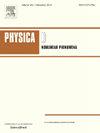On spectral scaling laws for averaged turbulence on the sphere
IF 2.7
3区 数学
Q1 MATHEMATICS, APPLIED
引用次数: 0
Abstract
Spectral analysis for a class of Lagrangian-averaged Navier–Stokes (LANS) equations on the sphere is carried out. The equations arise from the Navier–Stokes equations by applying a Helmholtz filter of width to the advecting velocity times, extending previous results on the Navier–Stokes- model and enabling a precise selection of the smallest length scale in the flow. Power laws for the energy spectrum are derived and indicate a -dependent scaling at wave numbers with . The energy and enstrophy transfer rates distinctly depend on the averaging, allowing control over the energy flux and the enstrophy flux separately through the choice of averaging operator. A necessary condition on the averaging operator is derived for the existence of the inverse cascade in two-dimensional turbulence. Numerical experiments with a structure-preserving integrator based on Zeitlin’s self-consistent truncation for hydrodynamics confirm the expected energy spectrum scalings and the robustness of the double cascade under choices of the averaging operator. The derived results have potential applications in reduced-complexity numerical simulations of geophysical flows on spherical domains.
球上平均湍流的谱标度规律
对球面上的一类拉格朗日平均Navier-Stokes (LANS)方程进行了谱分析。该方程由Navier-Stokes方程推导而来,采用宽度为α的Helmholtz滤波器对平流速度β倍进行滤波,扩展了先前在Navier-Stokes -α模型上的结果,并能够精确地选择流动中的最小长度尺度。导出了能谱的幂律,并表明在波数l αl < 1时存在β依赖的标度。能量和熵传递率明显依赖于平均,可以通过选择平均算子分别控制能量通量和熵通量。导出了二维湍流中逆叶栅存在的一个必要条件。基于Zeitlin自一致截断的保结构积分器的数值实验证实了在选择平均算子时双级联的预期能谱标度和鲁棒性。所得结果在简化的球域地球物理流动数值模拟中具有潜在的应用价值。
本文章由计算机程序翻译,如有差异,请以英文原文为准。
求助全文
约1分钟内获得全文
求助全文
来源期刊

Physica D: Nonlinear Phenomena
物理-物理:数学物理
CiteScore
7.30
自引率
7.50%
发文量
213
审稿时长
65 days
期刊介绍:
Physica D (Nonlinear Phenomena) publishes research and review articles reporting on experimental and theoretical works, techniques and ideas that advance the understanding of nonlinear phenomena. Topics encompass wave motion in physical, chemical and biological systems; physical or biological phenomena governed by nonlinear field equations, including hydrodynamics and turbulence; pattern formation and cooperative phenomena; instability, bifurcations, chaos, and space-time disorder; integrable/Hamiltonian systems; asymptotic analysis and, more generally, mathematical methods for nonlinear systems.
 求助内容:
求助内容: 应助结果提醒方式:
应助结果提醒方式:


